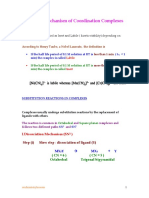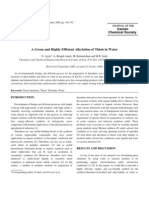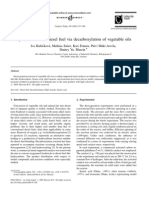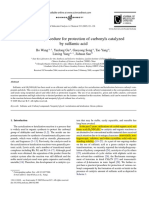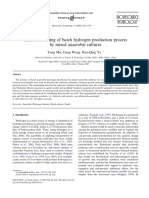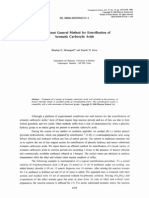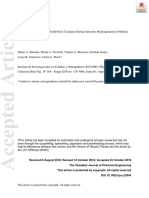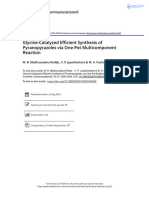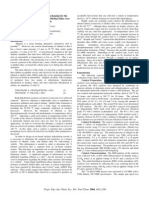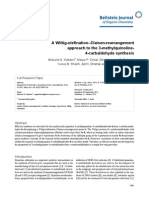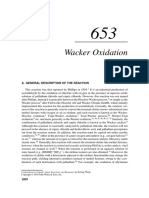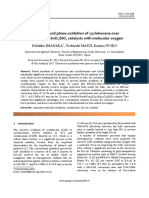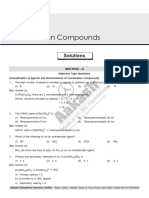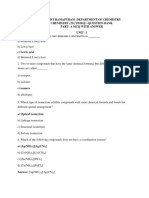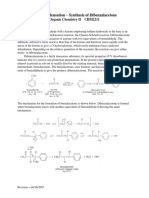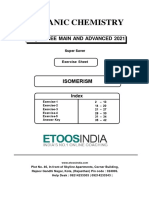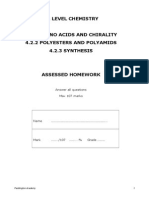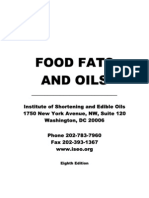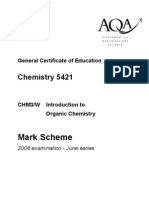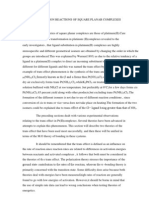Metathesis of Unsaturated Fatty Acids: Synthesis of Long-Chain Unsaturated-α
Metathesis of Unsaturated Fatty Acids: Synthesis of Long-Chain Unsaturated-α
Uploaded by
annisak fitriyanaCopyright:
Available Formats
Metathesis of Unsaturated Fatty Acids: Synthesis of Long-Chain Unsaturated-α
Metathesis of Unsaturated Fatty Acids: Synthesis of Long-Chain Unsaturated-α
Uploaded by
annisak fitriyanaOriginal Title
Copyright
Available Formats
Share this document
Did you find this document useful?
Is this content inappropriate?
Copyright:
Available Formats
Metathesis of Unsaturated Fatty Acids: Synthesis of Long-Chain Unsaturated-α
Metathesis of Unsaturated Fatty Acids: Synthesis of Long-Chain Unsaturated-α
Uploaded by
annisak fitriyanaCopyright:
Available Formats
Metathesis of Unsaturated Fatty Acids: Synthesis of
,
-Dicarboxylic Acids
Long-Chain Unsaturated-
Helen L. Ngo, Kerby Jones, and Thomas A. Foglia*
USDA, ARS, Eastern Regional Research Center, Wyndmoor, Pennsylvania 19038
ABSTRACT: The self-metathesis of readily available monounsaturated FA has the potential of being an important pathway for
the synthesis of symmetrical long-chain unsaturated-,-dicarboxylic acids (C18C26). Previous studies on the self-metathesis of
monounsaturated FA esters using ruthenium catalysts in solution,
however, suffered from low conversions as a result of the thermodynamic control of the reaction. We have found that the secondgeneration Grubbs catalyst can effectively catalyze the solventfree self-metathesis of monounsaturated FA of varying purity
(from 90 to 99%) to afford two important productsmonounsaturated dicarboxylic acids and hydrocarbonsin very high molar
conversions (>80%). This solvent-free self-metathesis reaction
also works for monounsaturated FA containing additional functional groups. Reactions were conducted at catalyst loadings as
low as 0.005 mol%, and turnover numbers as high as 10,800
could be obtained. This discovery represents an attractive approach to the large-scale production of useful monounsaturated,-dicarboxylic acids and long-chain unsaturated hydrocarbons
by means of this solvent-free ruthenium-catalyzed self-metathesis
of readily available monounsaturated FA.
Paper no. J11330 in JAOCS 83, 629634 (July 2006).
KEY WORDS: Dicarboxylic acids, erucic acid, Grubbs catalyst,
metathesis, oleic acid, ricinoleic acid.
Aliphatic dicarboxylic acids are important intermediates in the
synthesis of biodegradable polymers (1). Short-chain linear ,dicarboxylic acids such as suberic acid (C8), azelaic acid (C9), or
sebacic acid (C10), which can be derived from fats and oils by
chemical oxidation of unsaturated FA, are particularly important
building blocks for the synthesis of commercially important materials such as nylon, cosmetics, plasticizers, lubricants, and
greases (2,3). The chain length of the dicarboxylic acid in polymers is known to influence not only polymer properties but also
the polymer degradation rates (4). Accordingly, the availability
of a variety of ,-dicarboxylic acids of varying chain length
could potentially lead to new polymeric materials that possess
better performance and biodegradability. Research in producing
aliphatic ,-dicarboxylic acids of chain length >10 started in
the 1970s. Long-chain ,-dicarboxylic acids were produced by
either microbial oxidation or microbial fermentation (5). In the
1980s, several research groups reported that microorganisms in*To whom correspondence should be addressed at Fats, Oils and Animal Coproducts Research Unit, U.S. Department of Agriculture, Agricultural Research Service, Eastern Regional Research Center, 600 East Mermaid Ln.,
Wyndmoor, PA 19038. E-mail: tfoglia@arserre.gov
Copyright 2006 by AOCS Press
cluding Candida tropicalis or C. cloacae could transform n-alkanes and FA to dicarboxylic acids (6,7). Although microbial fermentation processes have been used for commercial production
of long-chain ,-dicarboxylic acids, there are environmental
concerns with these processes.
Alternatively, long-chain dicarboxylic acids can be synthesized by chemical approaches. In 1974, Van Dam et al. (8) reported the synthesis of long-chain dicarboxylic acids (C18C26)
by the self-metathesis of monounsaturated carboxylic acid esters in the presence of tungsten hexachloride (WCl6) and
tetramethyltin (Me4Sn) co-catalyst in chlorobenzene solution.
In this manner, monounsaturated fatty esters such as methyl octadec-9-enoate (methyl oleate, 3a, Scheme 1) were converted
to dicarboxylic esters with conversions ranging from 50 to
89%, and the diesters could be saponified and acidified to give
the long-chain dicarboxylic acids. In a subsequent study (9),
the co-metathesis of methyl oleate with dimethyl-3-hexenedioate was carried out using both homogeneous (WCl6,
Me4Sn) and heterogeneous (Re2O7/Al2O3) catalysts. Although
these synthetic approaches gave high selectivity and high conversions, the catalyst systems used suffered from low catalyst
turnover numbers.
In the 1990s, pioneering work by Grubbs (10) demonstrated
that homogeneous ruthenium-based catalysts are effective in
catalyzing olefin metathesis. Moreover, these catalysts, in contrast to the tungsten and rhenium catalysts, often tolerate functionally substituted alkenes. These ruthenium-based catalysts
have since been used to prepare ,-dicarboxylic acids or esters via metathetic routes. For example, Warwel et al. (1115)
reported a two-step process using Grubbs catalysts to prepare
long-chain unsaturated ,-dicarboxylic esters. Crossmetathesis of monounsaturated carboxylic acid methyl esters
with ethylene in the presence of the first-generation catalyst 1
(Fig. 1) in solution initially gave terminally unsaturated monocarboxylic methyl esters. The resulting terminal monounsaturated esters then underwent self-metathesis in the presence of 1
to give long-chain ,-dicarboxylic acid methyl esters with an
overall yield between 38 and 40%. Dinger and Mol (16) reported that self-metathesis of methyl oleate in dichloromethane
using the second-generation Grubbs catalyst 2 (Fig. 1) gave the
long-chain ,-dicarboxylic methyl ester 5a (Scheme 1, Eq. 1)
in ~45% conversion. Grubbs and Nguyen (17) reported the
self-metathesis of oleic acid in the presence of
Cl2(PCy3)2Ru=CHCH=CPh2 catalyst in dichloromethane solution to give 1,18-octadec-9-enedioic acid (5b) and octadec9-ene (4) in 42% yield.
629
JAOCS, Vol. 83, no. 7 (2006)
630
H.L. NGO ET AL.
SCHEME 1
Although long-chain ,-dicarboxylic acids and esters have
been successfully synthesized using ruthenium-catalyzed selfmetathesis routes, conversions are low since such reactions are
typically subject to thermodynamic control. In this paper, we
report the efficient solvent-free self-metathesis of monounsaturated FA catalyzed by second-generation Grubbs catalysts to
afford unsaturated ,-dicarboxylic acids and hydrocarbons in
very high conversions.
MATERIALS AND METHODS
Oleic acid (99%), 11-eicosenoic acid (99%), and ricinoleic acid
(99%) were from Nu-Chek-Prep (Elysian, MN). Oleic acid
(90%), erucic acid (90%), 10-undecenoic acid (98%), and the
Grubbs catalysts (1 and 2) were purchased from Aldrich Chemical (Milwaukee, WI). All other reagents used were of the highest purity obtainable from commercial suppliers.
1
H and 13C NMR spectra were collected at room temperature
in CD3OD either on a Varian Gemini 200-MHz or Varian Inova
400-MHz (Palo Alto, CA) spectrometer. Operating parameters
for 1H NMR were: cycle time (d1) = 1.0 s; acquisition time (at)
= 3.744 s; transmitter power (tpwr) = 57 Hz; pulse width (pw) =
90; operating parameters for 13C NMR were: cycle time (d1) =
2.0 s; acquisition time (at) = 2.399 s; transmitter power (tpwr) =
52 Hz; pulse width (pw) = 45. GC characterization of products
was carried out with a Hewlett-Packard (Agilent, Wilmington,
JAOCS, Vol. 83, no. 7 (2006)
DE) HP 6890 instrument with a capillary inlet (splitless mode).
The capillary column used was an HP DB-1 column (30 m
0.25 mm 0.25 mm) with carrier gas (N2) set at a linear velocity
of 22 cm/s at 100C. The oven temperature profile was: initial
temperature 50C; ramp at 15C /min to 220C; hold for 10 min;
ramp at 15C/min to 250C, hold for 5 min. GC/MS characterization of products was carried out with a Hewlett-Packard (Agilent) HP 5890 instrument with a capillary inlet (split-split mode)
and an HP Model 5972 mass detector set to scan from 40 to 550
m/z at a rate of 1.5 scans/s. The capillary column used was an HP
DB-5 column (30 m 0.25 mm 0.25 m) with carrier gas (He)
set at a linear velocity of 22 cm/s at 100C. The injector and detector transfer line temperatures were set at 250 and 280C, respectively. The oven temperature profile was: initial temperature
100C; ramp at 10C/min to 250C; hold for 5 min; ramp at
10C/min to 300C, hold for 5 min.
FIG. 1. First- and second-generation Grubbs catalysts. Cy, cyclohexyl.
LONG-CHAIN DICARBOXYLIC FATTY ACIDS
Synthesis of 1,18-octadec-9-enedioic acid (5b). Oleic acid
[3b; 89 g (90%), 0.315 mol] was transferred into a 250-mL
three-necked round-bottomed flask via syringe and outgassed
with nitrogen gas for 0.5 h. 1,3-Bis-(2,4,6-trimethylphenyl)-2(imidazolidinylidene)(dichlorophenylmethylene)(tricyclohexylphosphine)ruthenium (2; 267 mg, 0.315 mmol), a secondgeneration Grubbs catalyst, was then added. The reaction mixture was stirred with a mechanical stirrer and heated at 45C,
and after ~5 min the diacid began to precipitate from the reaction mixture. After 24 h reaction, ~10 mg of crude product was
removed from the reaction mixture and transferred to a 2-mL
dram vial. The crude diacid product (5b, Eq. 1) was added to 1
mL of methanol, and two drops of concentrated sulfuric acid
were added. The resulting mixture was heated at 80C for 0.5
h (18). The reaction mixture was then quenched with 2 mL of
1 M Na2CO3 and extracted with diethyl ether (3 2 mL); the
combined ether layers were then washed with water (3 2 mL).
The organic layer was dried with MgSO4, filtered, and solvent
was removed under reduced pressure. The methylated diacid
5a was then characterized by GC/MS (retention time = 18 min)
and gave an [M]+ of m/z 340 (calc. [M]+ for 5a is m/z =
340.26).
The remainder of the crude product was quenched with
ethyl vinyl ether (20 mL), and excess ether was removed under
reduced pressure. The residue was recrystallized twice from a
mixture of hexane (300 mL) and ethyl acetate (50 mL) to give
pure 1,18-octadec-9-enedioic acid (5b, Eq. 1) as a white solid:
m.p. 97.598.5 C [lit. m.p. 88C (8)]. Isolated yield: 35 g
(71%). 1H NMR of 1,18-octadec-9-enedioic acid (CD3OD, 400
MHz): 5.39 (m, CH=CH, 2H), 2.28 (t, J = 7.2 and 7.6 Hz,
CH2CO2H, 4H), 1.98 (m, 4H), 1.60 (m, 4H), 1.32 (m, 16H).
13
C NMR (CD3OD, 100 MHz): 177.8 (s, CO2H), 131.6 (s,
CH=CH), 35.1 (s), 33.7 (s), 30.8 (s), 30.4 (s), 30.3 (s), 30.2 (s),
26.2 (s).
Synthesis of 1,22-docos-11-enedioic acid (5c). 1,22-Docos11-enedioic acid (5c) was synthesized from 3c as described
above in the self-metathesis of oleic acid (3b). Pure 5c was obtained by recrystallization from a mixture of hexane (100 mL)
and ethyl acetate (10 mL) to give 5c in 74% yield (m.p. =
104106.5C). The methyl ester of diacid 5c was analyzed by
GC/MS: (retention time t = 24 min) and had an [M]+ of m/z 396
(calc. [M]+ for 5c is m/z = 396.60). 1H NMR (CD3OD, 400
MHz): 5.4 (m, CH=CH, 2H), 2.28 (t, J = 7.6 and 7.2 Hz,
CH2CO2H, 4H), 1.99 (m, 4H), 1.58 (m, 4H), 1.31 (m, 24H).
13
C NMR (CD3OD, 100 MHz): 177.9 (s, CO2H), 131.7 (s,
CH=CH), 35.2 (s, CH2CO2H), 33.7 (s), 30.9 (s), 30.7 (s), 30.6
(s), 30.5 (s), 30.4 (s), 30.3 (s), 26.2 (s).
Synthesis of 1,26-hexacos-13-enedioic acid (5d). Diacid 5d
was synthesized from 3d as above. The pure diacid was obtained by recrystallization from acetone in a yield of 70%, m.p.
= 105107.5 oC [lit. m.p. = 96 C (8)]. The methyl ester of
diacid 5d was analyzed by GC/MS (retention time t = 28.2
min) and had an [M]+ of m/z 452 (calc. [M]+ m/z 452.38). 1H
NMR (CD3OD, 200 MHz): 5.4 (m, CH=CH, 2H), 2.28 (t, J
= 7.4 Hz, CH2CO2H, 4H), 1.97 (m, CH2CH=CH, 4H), 1.6 (m,
4H), 1.30 (m, 32H). 13C NMR (CD3OD, 50 MHz): 177.9 (s,
631
CO2H), 131.7 (s, CH=CH), 35.2 (s), 33.7 (s), 30.9 (s), 30.8
(s), 30.78 (s), 30.7 (s), 30.6 (s), 30.4 (s), 30.3 (s), 26.3 (s).
Synthesis of 1,20-eicos-10-enedioic acid (7). Similar to oleic
acid, 10-undecenoic acid [6; 10 g (98%), 0.054 mol] underwent
self-metathesis in the presence of 46 mg (0.054 mmol) of catalyst 2. The reaction flask was attached to a mineral oil bubbler,
which allowed the gaseous ethylene co-product to escape. The
mixture was stirred with a mechanical stirrer and heated at
45C, and after ~5 min reaction a white precipitate was observed. After 72 h reaction a small amount of the crude product was removed from the reaction mixture and methylated as
above for GC/MS analysis.
The remainder of the reaction mixture was quenched with
ethyl vinyl ether (~20 mL) and unreacted ether removed under
reduced pressure. The residue was recrystallized twice from
~100 mL of acetone to give pure 1,20-eicos-10-enedioic acid
(7) as a white solid with m.p. = 110110.5C [lit. m.p. 108C
(8)]. The isolated yield was 7.5 g (82%). The methyl ester of
diacid 7 was analyzed by GC/MS (retention time t = 23.9 min)
and had an [M]+ of m/z 368 (calc. [M]+ m/z for 368.30). 1H
NMR (CD3OD, 400 MHz): 5.39 (m, CH=CH, 2H), 2.28
(t, J = 7.2 and 7.6 Hz, CH2CO2H, 4H), 1.97 (m, 4H), 1.58 (m,
4H), 1.31 (m, 20H). 13C NMR (CD3OD, 100 MHz): 177.8 (s,
CO2H), 131.7 (s, CH=CH), 35.1 (s), 33.7 (s), 30.9 (s), 30.6
(s), 30.4 (s), 30.2 (s), 26.2 (s).
Synthesis of 7,12-dihydroxyoctadec-9-ene (9). Ricinoleic
acid (8, 400 mg 1.34 mmol) was mixed with 2 (11 mg, 0.013
mmol) in a 50-mL Schlenk tube under nitrogen gas flow and
the mixture was heated at 50C. After ~0.5 h, a small amount
of white precipitate was observed in the reaction flask. After 3
d of stirring at 50C, the reaction mixture was quenched with 2
mL of ethyl vinyl ether, and the volatile components were removed under reduced pressure. The crude product contained
the diol 9, ricinoleic acid, and diacid 5b was methylated using
the procedure described above. The methylated product (116
mg) was reacted with 400 L of N,O-bis(trimethylsilyl)trifluoroacetamide and 120 L of pyridine at room temperature for 1
h (18). The silylated product was purified by passage through a
silica gel column [~20 g; i.d. length 1.2 25 cm (0.5
10in.)] using hexane/ethyl acetate (9:1 vol/vol) as eluant to give
34.5 mg of 7,12-bis(trimethylsiloxy)octadec-9-ene (9a) as a
yellow oil, 28.9 mg of the silylated methyl ester of 8, and 35.3
mg of the methyl ester of 5b. Both steps gave quantitative reaction yields. GC/MS of 9a (retention time t = 15.8 min) gave
an [M]+ at m/z = 427 (calc. [M]+ for 9a is m/z = 428.84). 1H
NMR of 9a (CDCl3, 200 MHz): 5.43 (m, CH2CH=CH, 2H),
3.6 (m, CHOSi(CH3)3, 2H), 2.14 (m, CH2CH=CH, 4H), 1.26
(m, 20H), 0.878 (m, 6H), 0.085 (s, OSi(CH3)3, 18H). 13C
NMR of 9a (CDCl3, 50 MHz): 129.1 (s, CH=CH), 72.7 (s,
CHOSi(CH3)3), 41.2 (s), 37.1 (s), 31.9 (s), 29.4 (s), 25.7 (s),
22.6 (s), 14.1 (s, CH3), 0.414 (s, OSi(CH3)3).
RESULTS AND DISCUSSION
The solvent-free self-metathesis of oleic acid was carried out
under a nitrogen atmosphere with 0.1 mol% of Grubbs catalyst
JAOCS, Vol. 83, no. 7 (2006)
632
H.L. NGO ET AL.
TABLE 1
Ruthenium-Catalyzed Self-Metathesis of Unsaturated FA/Estersa
Entry
Fatty ester/FAb
% Conv.c
% Isolated diester/acid
,-Dicarboxylic ester/acid
Alkene
1,18-Dimethyl octadec-9enedioate (5a)
1,18-Octadec-9enedioic acid (5b)
1,22-Docos-11enedioic acid (5c)
1,26-Hexacos-13enedioic acid (5d)
1,20-Eicos-10enedioic acid (7)
1,18-Octadec-9enedioic acid (5b)
Mixture of diacidsi
Octadec-9-ene (4)
Methyl oleate (3a, 99%)
50
39
Oleic acid (3b, 90%)
79
71e
11-Eicosenoic acid (3c, 99%)
77
74e
Erucic acid (3d, 90%)
74
70f
10-Undecenoic acid (6, 98%)
87
82e
Ricinoleic acid (8, 99%)
63
40f,g,h
Linoleic acid (10, 99%)
56
Octadec-9-ene
Octadec-9-ene
Octadec-9-ene
Ethene
7,12-Dihydroxyoctadec-9-ene (9)
Mixture of alkenesj
All the reactions were carried out with 0.1 mol% catalyst 2 (Fig. 1) at 45C for 3 d.
b
Starting FA/fatty ester (percent purity) and products shown in Schemes 1 and 2.
c
Percent conversion determined by GC and expressed as alkene + diacid/ alkene + diacid + FA. Dodecane used as the internal reference.
d
Dimethyl ester isolated by silica gel chromatography.
e
Isolated by recrystallizing from hexane/ethyl acetate.
f
Isolated by recrystallizing from acetone.
g
Product is methyl octadec-9-enedioate.
h
Reaction carried out at 1.0 mol% catalyst loading.
i
Diacid product (35%) composed of the following acids: C18:1; C21:5; C26:3 as determined by GC/MS of the reaction product after conversion to methyl
esters.
j
Alkene product (24%) composed of the following alkenes: C12:1; C15:2; C18:3 as determined by GC/MS of reaction mixture.
2 (Fig. 1). Catalyst 2 was chosen since, unlike earlier ruthenium-based metathesis catalysts, it was expected to tolerate the
presence of functional groups such as the carboxyl group of
oleic acid. In general, at a reaction temperature of 45C, the
diacid products started to precipitate from the reaction mixture
after ~ 5 min. The reactions are preferably performed between
45 and 55C. This temperature range is critical since the starting cis FA readily isomerize to trans isomers in the presence of
the catalyst. Thus at reaction temperatures <40C, the reaction
mixtures solidify, which results in low conversion of starting
acids to products. On the other hand, at temperatures >55C the
reaction mixtures remain liquid, which result in equilibrium
processes and lower conversions. With the reaction conditions
used in this work, the starting FA were retained as liquids so
that they can further react with the catalyst to generate more
diacids. Prolonged stirring of this mixture (48 h) led to the formation of 1,18-octadec-9-enedioic acid (5b) and octadec-9-ene
(4), two potentially important oleochemical intermediates in
79% conversion (Scheme 1, Eq. 1). After quenching the reaction, the mixture was crystallized from hexane/ethyl acetate to
give analytically pure 5b in 71% isolated yield (Table 1, entry
2). The IR spectrum of 5b indicated that the double bond on
the alkyl chain is predominantly trans geometry. Octadec-9ene (4) was purified by silica-gel column chromatography of
the resulting crystallization mixture (after removal of solvent)
using hexane as the eluant. All long-chain, unsaturated-,-dicarboxylic acids and co-product alkenes reported in this study
were characterized by 1H and 13C NMR spectroscopy and
GC/MS. We also used oleic acid of varying purity (90 and
99%) and found that the self-metathesis reaction works equally
well for both oleic acids, indicating the tolerance of 2 to the im-
JAOCS, Vol. 83, no. 7 (2006)
purities in the starting oleic acid (primarily saturated FA). The
level of conversion achieved here is higher than that previously
obtained for ruthenium-catalyzed self-metathesis of FA (typically less than 50%). For comparison, we have carried out a
control experiment with methyl oleate under similar conditions
(Entry 1 in Table 1). In this instance, the self-metathesis of
methyl oleate resulted in an equilibrium distribution of products (50% conversion of 3a), and an isolated yield of dimethyl9-octadecenoate (5a, 39%) was obtained by silica-gel column
chromatography. The significant difference in conversion between oleic acid and methyl oleate is a result of the low solubility of diacid 5b in the oleic acid and octadec-9-ene reaction
mixture. As self-metathesis of 3b proceeds, diacid 5b precipitates out of the solution, and the equilibrium is pushed toward
the diacid products (Scheme 1, Eq. 1) because of Le Chateliers
Principle.
As shown in Table 1, the solvent-free self-metathesis reaction is general, and other FA were self-metathesized using catalyst 2 under similar conditions to give the unsaturated dicarboxylic acids and hydrocarbons listed in Table 1 in comparatively high conversions. In addition to oleic acid, the
self-metatheses of 11-eicosenoic (3c) and erucic (3d) acids also
were investigated, and in both cases a high conversion to
diacids 5c and 5d (Scheme 1, Eq.1) was obtained. As expected,
the self-metathesis of 10-undecenoic acid (6) resulted in high
yields of diacid 7 (Scheme 1, Eq. 2) because the co-product ethylene readily escapes from the reaction mixture, which further
pushes the reaction equilibrium to the diacid products. In this
instance, a conversion of 87% was obtained, and analytically
pure 10-eicosenedioic acid (7) was obtained in 82% isolated
yield.
LONG-CHAIN DICARBOXYLIC FATTY ACIDS
633
TABLE 2
Effect of Catalyst Loading on the Ruthenium-Catalyzed Metathesis of Unsaturated FAa
Entry
1
2
3
4
5
FA
Catalyst loading (mol%)
% Conversionb
Oleic (3b, 90%)
Oleic (3b, 90%)
Oleic (3b, 90%)d
10-Undecenoic (6, 98%)
10-Undecenoic (6, 98%)d
0.1
0.01
0.005
0.1
0.01
79
66
54
87
64
TONc
790
6600
10,800
870
6400
All reactions were carried out with catalyst 2 (Fig. 1) at 45C for 48 h.
Determined by GC and expressed as alkene + diacid/ alkene + diacid + FA.
c
TON = catalyst turnover number defined as % conversion/mol% catalyst loading.
d
Acid dried with molecular sieves for 24 h and then vacuum distilled at 180C before use.
b
SCHEME 2
Interestingly, the solvent-free self-metathesis reaction also
works well with FA containing other functional groups. For example, ricinoleic acid, which has a hydroxyl group on the 12
position of the alkyl chain, underwent self-metathesis to afford
1,18-octadec-9-enedioic acid and 7,12-dihydroxyoctadec-9ene with high selectivity and conversion up to 63% (Scheme 1,
Eq. 3).
We also found that the self-metathesis of monounsaturated
FA works well at low catalyst loading (Table 2). For example,
self-metathesis of 10-undecenoic acid with catalyst loading of
0.01 mol % gave 1,20-eicos-10-enedioic acid with high selectivity and conversion up to 64%. Self-metathesis of oleic acid
with 0.005 mol% catalyst loading gave 1,18-octadec-9-enedioic acid and octadec-9-ene with high selectivity and 54%
conversion. A turnover number as high as 10,800 was obtained
under these non-optimized conditions.
Self-metathesis of linoleic acid (10) in the presence of ruthenium catalyst 2 gave a more complex product mixture (Scheme
2) since both double bonds in linoleic acid are subject to selfmetathesis. For example, self-metathesis of both of the 9,10
double bonds between two linoleic acid molecules yields C18diacid 5b and C18-triene 11 (Scheme 2) whereas metathesis between both of the 12,13 double bonds gives C24-diacid 12 and
the C12-monoene 13 (Scheme 2). Alternatively, self-metathesis
can occur between the 9,10 double bond of one linoleic acid
molecule and the 12,13 double bond of a second linoleic acid
molecule. The complexity of this reaction is further compounded, since each of the newly formed alkenes and unsaturated acids can in turn undergo cross-metathesis to produce
compounds 14 and 15 (Scheme 2) so that a very complex product mixture is obtained. Although we have not determined all
the hydrocarbons and ,-dicarboxylic acid products in this
mixture, we were able to identify the compounds shown in
Scheme 2 by GC/MS techniques and estimate a conversion of
56% based on the amount of unreacted linoleic acid.
ACKNOWLEDGMENTS
We thank Dr. Alberto Nuez for technical support for obtaining the
GC/MS and Dr. Gary Strahan for helpful advice on NMR spectrometry.
JAOCS, Vol. 83, no. 7 (2006)
634
H.L. NGO ET AL.
REFERENCES
1. Gunatillake, P.A., and R. Adhikari, Biodegradable Synthetic
Polymers for Tissue Engineering, Eur. Cells Mater. 5:116
(2003).
2. Johnson, R.W., Fatty Acids in Industry, Marcel Dekker, New
York, 1989.
3. Pattison E.S., Fatty Acids and Their Industrial Applications,
Marcel Dekker, NewYork, 1968, p. 301.
4. Kroha, K., Industrial Biotechnology Provides Opportunities for
Commercial Production of New Long-Chain Dibasic Acids, inform 15:568571.
5. Atomi, H., C. Yu, and A. Hara, Characterization of a Dicarboxylic Acid-Producing Mutant of the Yeast Candida tropicalis, J. Ferment. Bioeng. 77:205207 (1994).
6. Liu, S., C. Li, X, Fang, and Z. Cao, Z. Optimal pH Control Strategy for High-Level Production of Long-Chain ,-Dicarboxylic Acid by Candida tropicalis, Enzyme Microbiol. Technol. 34:7377 (2004).
7. Hill, F.F., I. Venn, and K.L. Lukas, Studies on the Formation of
Long-Chain Dicarboxylic Acids from Pure n-Alkanes by a Mutant of Candida tropicalis, Appl. Microbiol. Biotechnol.
24:168174 (1986).
8. Van Dam, P.B., M.C. Mittelmeijer, and C. Boelhouwer, Homogeneous Catalytic Metathesis of Unsaturated Fatty Esters: New
Synthetic Method for Preparation of Unsaturated Mono- and Dicarboxylic Acids, J. Am. Oil Chem. Soc. 51:389391 (1974).
9. Kohashi, H., and T.A. Foglia, Metathesis of Methyl Oleate with
a Homogeneous and a Heterogeneous Catalyst, Ibid.
62:549554 (1985).
JAOCS, Vol. 83, no. 7 (2006)
10. Grubbs, R.H., Handbook of Metathesis, Wiley-VCH, Verlag
GmbH & Co. KGaA, Weinheim, 2003.
11. Warwel, S., C. Demes, and G.J. Steinke, Polyesters by LipaseCatalyzed Polycondensation of Unsaturated and Epoxidized
Long-Chain ,-Dicarboxylic Acid Methyl Esters with Diols,
Polym. Sci. Part A: Polym. Chem. 39:16011609 (2001).
12. Warwel, S., F. Brse, C. Demes, and M. Kunz, Polymers and
Polymer Building Blocks from Meadowfoam Oil, Ind. Crops
Prod. 20:301309 (2004).
13. Warwel, S., J. Tillack, C. Demes, and M. Kunz, Polyesters of
-Unsaturated Fatty Acid Derivatives, Macromol. Chem. Phys.
202:11141121 (2001).
14. Warwel, S., B. Wiege, E. Fehling, and M. Kunz, Copolymerization of Ethylene with -Unsaturated Fatty Acid Methyl Esters
Using a Cationic Palladium Complex, Ibid. 202:849855
(2001).
15. Warwel, S., F. Brse, C. Demes, M. Kunz, and M. Klaas, Polymers and Surfactants on the Basis of Renewable Resources,
Chemosphere 43:3948 (2001).
16. Dinger, M.B., and J.C. Mol, High Turnover Numbers with
Ruthenium-Based Metathesis Catalysts, Adv. Synth. Catal.
344:671677 (2002).
17. Grubbs, R.H., and S.T. Nguyen, Polymer Depolymerization
Using Ruthenium and Osmium Carbene Complexes, U.S.
Patent 5,728,917 (1998).
18. Christie, W.W., Lipid Analysis: Isolation, Separation, Identification, and Structural Analysis of Lipids, Oxford, New York,
Pergamon Press, 1982.
[Received February 6, 2006; accepted May 16, 2006]
You might also like
- Body Makeover: Essential GuideDocument27 pagesBody Makeover: Essential GuideMerlin HawkNo ratings yet
- Newman Projections Practice Problems-AnswersDocument4 pagesNewman Projections Practice Problems-AnswersNatasha Nadya Hussin100% (1)
- Reductive Methylation of Primary and Secondary Amines and Amino Acids by Aqueous Formaldehyde and ZincDocument3 pagesReductive Methylation of Primary and Secondary Amines and Amino Acids by Aqueous Formaldehyde and Zincjavasolo100% (1)
- Reaction Mechanism of Coordination ComplexesDocument7 pagesReaction Mechanism of Coordination ComplexesMartinMagu0% (1)
- Metathesis of Unsaturated Fatty Acids: Synthesis of Long-Chain Unsaturated-??,??-Dicarboxylic AcidsDocument7 pagesMetathesis of Unsaturated Fatty Acids: Synthesis of Long-Chain Unsaturated-??,??-Dicarboxylic AcidsByounghak KimNo ratings yet
- Cholin BaseDocument5 pagesCholin Basex_aav3No ratings yet
- Chenligong 200711 9Document9 pagesChenligong 200711 9Aleksa LukicNo ratings yet
- Ken Dell 2010Document18 pagesKen Dell 2010Juan CamiloNo ratings yet
- Thiols Formation in Presence of K2co3Document5 pagesThiols Formation in Presence of K2co3Harjinder Singh BhatiaNo ratings yet
- Un Bonito BonitoDocument4 pagesUn Bonito BonitojuanitoNo ratings yet
- An Efficient Procedure For Protection of Carbonyls Catalyzed by Sulfamic AcidDocument6 pagesAn Efficient Procedure For Protection of Carbonyls Catalyzed by Sulfamic AcidVina Octavia AzzahraNo ratings yet
- Production Hydrogen ModelDocument6 pagesProduction Hydrogen ModelJean OrellanaNo ratings yet
- Preparation of Biodiesel Catalyzed by Solid Super Base of Calcium Oxide and Its Refining ProcessDocument6 pagesPreparation of Biodiesel Catalyzed by Solid Super Base of Calcium Oxide and Its Refining ProcessdGNo ratings yet
- Epoxidation of Methyl Oleate Using Heterogeneous CatalystDocument3 pagesEpoxidation of Methyl Oleate Using Heterogeneous CatalystYustinus KrisnaNo ratings yet
- A Simple, Green and One-Pot Four-Component Synthesis of 1,4-Dihydropyridines and Their AromatizationDocument6 pagesA Simple, Green and One-Pot Four-Component Synthesis of 1,4-Dihydropyridines and Their AromatizationEdgar HernándezNo ratings yet
- Itaconic Acid As CatalystDocument5 pagesItaconic Acid As CatalystmalikNo ratings yet
- Catalytic Application of Al-MCM-41 in The Esterification of Acetic Acid With Various AlcoholsDocument9 pagesCatalytic Application of Al-MCM-41 in The Esterification of Acetic Acid With Various AlcoholsJenny CórdobaNo ratings yet
- Investigation of Biodiesel Production From Canola Oil Using Mg-Al Hydrotalcite CatalystsDocument6 pagesInvestigation of Biodiesel Production From Canola Oil Using Mg-Al Hydrotalcite CatalystsApril TanjayNo ratings yet
- Effect of Poly (Acrylic Acid) End-Group Functionality On Inhibition of Calcium Oxalate Crystal GrowthDocument7 pagesEffect of Poly (Acrylic Acid) End-Group Functionality On Inhibition of Calcium Oxalate Crystal GrowthPencils SharpenerNo ratings yet
- 1 s2.0 0040403996013512 MainDocument4 pages1 s2.0 0040403996013512 MainSupriya SomvanshiNo ratings yet
- Synthesis of Biodiesel From Soybean Oil Using Heterogeneous Kf/Zno CatalystDocument7 pagesSynthesis of Biodiesel From Soybean Oil Using Heterogeneous Kf/Zno CatalystitzelselNo ratings yet
- O Nucleophilic Amino Alcohol Acyl Transfer Catalysts The Effect of Acidity of The Hydroxyl Group On The Activity of The CatalystDocument4 pagesO Nucleophilic Amino Alcohol Acyl Transfer Catalysts The Effect of Acidity of The Hydroxyl Group On The Activity of The Catalystbruenor304amancaboihNo ratings yet
- Wenlei 2006Document7 pagesWenlei 2006Hajarul MassiNo ratings yet
- 18-7-14 Litrature - Fatty AlcoholDocument7 pages18-7-14 Litrature - Fatty AlcoholAkash PagareNo ratings yet
- Benzylic Oxide PDFDocument3 pagesBenzylic Oxide PDFebi1364No ratings yet
- Esterification and Transesterification Assisted by Microwaves of Crude Palm Oil. Homogeneous CatalysisDocument6 pagesEsterification and Transesterification Assisted by Microwaves of Crude Palm Oil. Homogeneous CatalysisMáximo Décimo MeridioNo ratings yet
- Article in PressDocument10 pagesArticle in PressDyah Ratri RahadiniNo ratings yet
- Acs Oprd 5b00359 PDFDocument5 pagesAcs Oprd 5b00359 PDFTan Chee SiangNo ratings yet
- The Intermetallic Catalysts For Oxidative Esterification of Methacrolein To Methyl MethacrylateDocument5 pagesThe Intermetallic Catalysts For Oxidative Esterification of Methacrolein To Methyl MethacrylatePau ZalazarNo ratings yet
- BiodieselDocument7 pagesBiodieselArceo A HenryNo ratings yet
- Friedel Crafts Acylation - ArticleDocument10 pagesFriedel Crafts Acylation - ArticleM Zeeshan aliNo ratings yet
- Efficient Synthesis of 3-Cyano-6 - (2-Hydroxyphenyl) Pyridines by Multi-Component Condensations On BeadsDocument3 pagesEfficient Synthesis of 3-Cyano-6 - (2-Hydroxyphenyl) Pyridines by Multi-Component Condensations On BeadsBandita DattaNo ratings yet
- Sepulveda 2011Document6 pagesSepulveda 2011Glorie Mae BurerosNo ratings yet
- CR 100258 KDocument35 pagesCR 100258 KzoyudgNo ratings yet
- Catalytic Hydrogenation of Levulinic Acid in Aqueous PhaseDocument3 pagesCatalytic Hydrogenation of Levulinic Acid in Aqueous Phasejoe2ndolNo ratings yet
- Hydrogenation of Methyl Oleate of Fatty Alcohol. 05Document19 pagesHydrogenation of Methyl Oleate of Fatty Alcohol. 05GamalielNo ratings yet
- 2 Habova PDFDocument8 pages2 Habova PDFCamilo Botero ZapataNo ratings yet
- Silicotungstic Acid Supported Zirconia: An Effective Catalyst For Esterification ReactionDocument7 pagesSilicotungstic Acid Supported Zirconia: An Effective Catalyst For Esterification ReactionJenny CórdobaNo ratings yet
- Sodium Nitrite Catalyzed Aerobic Oxidative Deoximation Under Mild ConditionsDocument4 pagesSodium Nitrite Catalyzed Aerobic Oxidative Deoximation Under Mild ConditionsCláudio SerafimNo ratings yet
- Reddy 2010Document6 pagesReddy 2010Bandita DattaNo ratings yet
- 49 2 Philadelphia 10-04 1181Document4 pages49 2 Philadelphia 10-04 1181lumengentiunNo ratings yet
- Esterification Process To Synthesize Isopropyl Chloroacetate Catalyzed by Lanthanum Dodecyl SulfateDocument6 pagesEsterification Process To Synthesize Isopropyl Chloroacetate Catalyzed by Lanthanum Dodecyl SulfateVinay JainNo ratings yet
- A Wittig-olefination-Claisen-rearrangement Approach To The 3-Methylquinoline-4-Carbaldehyde SynthesisDocument5 pagesA Wittig-olefination-Claisen-rearrangement Approach To The 3-Methylquinoline-4-Carbaldehyde SynthesisMuhammad Mirza HardiansyahNo ratings yet
- EpscDocument6 pagesEpscVohinh NgoNo ratings yet
- Wacker Oxidation: A. General Description of The ReactionDocument6 pagesWacker Oxidation: A. General Description of The Reactionnabila OktavianiNo ratings yet
- Oxyfunctionalization of Natural Terpenes Catalyzed by La SR Mno in Water As Solvent: An Experimental and Theoretical StudyDocument16 pagesOxyfunctionalization of Natural Terpenes Catalyzed by La SR Mno in Water As Solvent: An Experimental and Theoretical Studywiam wiamNo ratings yet
- Molecules: Liquid-Phase Synthesis of Cyanuric Acid From UreaDocument5 pagesMolecules: Liquid-Phase Synthesis of Cyanuric Acid From UreaSrujana BudheNo ratings yet
- Sintesis Zyegler de AlcoholesDocument5 pagesSintesis Zyegler de AlcoholesJuan Carlos VillotaNo ratings yet
- Bioresources: Estimation of Hardwood Lignin Concentrations by Uv Spectroscopy and Chlorine DemethylationDocument13 pagesBioresources: Estimation of Hardwood Lignin Concentrations by Uv Spectroscopy and Chlorine DemethylationThiago SantosNo ratings yet
- Articulo ProyectoDocument9 pagesArticulo ProyectoHenry ArenasNo ratings yet
- Transesterification of Soybean Oil For Biodiesel Production Using Hydrotalcite As Basic CatalystDocument6 pagesTransesterification of Soybean Oil For Biodiesel Production Using Hydrotalcite As Basic Catalystevin34No ratings yet
- Vinicius Rossa, Production of Solketal Using Acid Zeolites As CatalystsDocument18 pagesVinicius Rossa, Production of Solketal Using Acid Zeolites As Catalystsnysa arientikaNo ratings yet
- Boyang Wang, Shufen Li, Songjiang Tian, Rihua Feng, Yonglu MengDocument6 pagesBoyang Wang, Shufen Li, Songjiang Tian, Rihua Feng, Yonglu MengHuệ KimNo ratings yet
- A Facile Synthesis of Alkyl Substituted Maleic Anhydrides Radical ApproachDocument4 pagesA Facile Synthesis of Alkyl Substituted Maleic Anhydrides Radical ApproachShaik SameerNo ratings yet
- Proline Biosynthesis in Escherichia ColiDocument7 pagesProline Biosynthesis in Escherichia ColilespecheNo ratings yet
- Salanitro Muirhead 1975 Quantitative Method For The Gas Chromatographic Analysis of Short Chain Monocarboxylic andDocument8 pagesSalanitro Muirhead 1975 Quantitative Method For The Gas Chromatographic Analysis of Short Chain Monocarboxylic andVictor Candel AlmaidaNo ratings yet
- Epoxidation of Alkenes With Hydrogen PeroxideDocument7 pagesEpoxidation of Alkenes With Hydrogen PeroxidechidambaramrNo ratings yet
- Catalysis Communications: Suresh D. Salim, Krishnacharya G. AkamanchiDocument4 pagesCatalysis Communications: Suresh D. Salim, Krishnacharya G. AkamanchinileshsalunkheNo ratings yet
- Imanaka2015 Article SelectiveLiquidPhaseOxidationODocument7 pagesImanaka2015 Article SelectiveLiquidPhaseOxidationOcamilcaNo ratings yet
- Catalyst Acids Ie901175dDocument4 pagesCatalyst Acids Ie901175dZamri FadilahNo ratings yet
- Sustainable synthesis of ciclopentene derivatives through multicomponent reactions in continuous flow regimeFrom EverandSustainable synthesis of ciclopentene derivatives through multicomponent reactions in continuous flow regimeNo ratings yet
- Nanoporous Catalysts for Biomass ConversionFrom EverandNanoporous Catalysts for Biomass ConversionFeng-Shou XiaoNo ratings yet
- Hydrogen Production TechnologiesFrom EverandHydrogen Production TechnologiesMehmet SankirNo ratings yet
- Cambridge International Advanced Subsidiary and Advanced LevelDocument24 pagesCambridge International Advanced Subsidiary and Advanced LevelAli110No ratings yet
- CHE 112 - Lecture 2Document103 pagesCHE 112 - Lecture 2Martias WambiNo ratings yet
- CHEM1920 Lecture 3 (Corrected)Document64 pagesCHEM1920 Lecture 3 (Corrected)Kahelia CampbellNo ratings yet
- 9 Isomerism-Exercise PDFDocument36 pages9 Isomerism-Exercise PDFTHE INDIAN JOKERNo ratings yet
- Coordination Copounds NotesDocument22 pagesCoordination Copounds NotesGaurav SinghaNo ratings yet
- CLS Aipmt-18-19 XIII Che Study-Package-5 SET-1 Chapter-19 PDFDocument28 pagesCLS Aipmt-18-19 XIII Che Study-Package-5 SET-1 Chapter-19 PDFÀàkàrsh YàduvàñshiNo ratings yet
- MCQ 21cyb101j Unit 1Document10 pagesMCQ 21cyb101j Unit 1jjamunagandhiNo ratings yet
- Organic Chemistry Presentation 2011 11 07 1 Slide Per Page PDFDocument97 pagesOrganic Chemistry Presentation 2011 11 07 1 Slide Per Page PDFZackNo ratings yet
- NMR SplittingDocument36 pagesNMR SplittingsabbysamuraNo ratings yet
- Chapter 12 Organic Chemistry Some Basic Principles and Techniques PDFDocument21 pagesChapter 12 Organic Chemistry Some Basic Principles and Techniques PDFNitish MehraNo ratings yet
- 13.E ExercisesDocument13 pages13.E ExercisesSadan ShawabikahNo ratings yet
- Aldol InstrDocument7 pagesAldol Instrmed jrNo ratings yet
- Master Question Bank: Inorganic ChemistryDocument29 pagesMaster Question Bank: Inorganic ChemistryRadhakrishna Murty TatavartyNo ratings yet
- Lecture 5-AlkenesDocument34 pagesLecture 5-Alkenesanasattiq078No ratings yet
- Merino 2002Document18 pagesMerino 2002محمد بلحوتNo ratings yet
- AIEEE - 2009 Paper With Solutions For Physics, Chemistry and MathsDocument16 pagesAIEEE - 2009 Paper With Solutions For Physics, Chemistry and Mathsstudysteps.in0% (1)
- Isomerism Sheet - by NJ Sir PDFDocument42 pagesIsomerism Sheet - by NJ Sir PDFVikas Rana100% (2)
- 2,3-Trans-3,4-Trans-3,4-Dihydroxy-L-proline An Amino Acid in Toxic Peptides of Amanita Virosa MushroomsDocument2 pages2,3-Trans-3,4-Trans-3,4-Dihydroxy-L-proline An Amino Acid in Toxic Peptides of Amanita Virosa MushroomsArmando BetancourthNo ratings yet
- HOMEWORK Polymers and SynthesisDocument21 pagesHOMEWORK Polymers and SynthesisRobert EdwardsNo ratings yet
- Food Fats and Oils Institute of Shortening and Edible Oil 8ava CampbellDocument46 pagesFood Fats and Oils Institute of Shortening and Edible Oil 8ava Campbellrcrochar100% (1)
- Metal complexes of hydroxynaphthoquinones: Lawsone, bis-lawsone, lapachol, plumbagin and jugloneDocument24 pagesMetal complexes of hydroxynaphthoquinones: Lawsone, bis-lawsone, lapachol, plumbagin and jugloneMahmood ȜemadNo ratings yet
- Chemical Incompatibility Part2Document11 pagesChemical Incompatibility Part2Dina KhalidNo ratings yet
- UNIT-II: Fats and Oils. Dr. Sumanta Mondal - Lecture Notes - Pharmaceutical Organic Chemistry-II (BP 301T) - B.Pharm-III SemDocument17 pagesUNIT-II: Fats and Oils. Dr. Sumanta Mondal - Lecture Notes - Pharmaceutical Organic Chemistry-II (BP 301T) - B.Pharm-III SemAldrin BlasNo ratings yet
- Aqa Chem3Document15 pagesAqa Chem3bento1995705No ratings yet
- B.SC Organic Chemistry (Paper-5) - Q and ADocument59 pagesB.SC Organic Chemistry (Paper-5) - Q and ASyed furkhanNo ratings yet
- Ligand Subsitution Reactions of Square Planar ComplexesDocument6 pagesLigand Subsitution Reactions of Square Planar ComplexesSharon DunneNo ratings yet
- Chem 3 - Elimination Reactions in HalogenoalkanesDocument58 pagesChem 3 - Elimination Reactions in HalogenoalkanesFeaid Aina OrnedoNo ratings yet



